Chapter: Physics : Photonics and fibre Optics
Types of Optical Fibers
TYPES OF OPTICAL FIBERS
Optical fibers are classified into three major categories
i. The type of material used
ii. The number of modes
iii. The refractive index profile
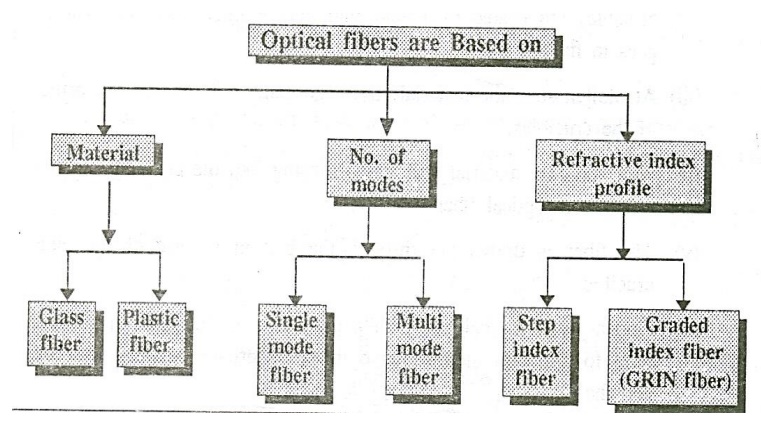
Based on the type of the material used, they are classified into two types
1. Glass fiber:
Example:
Core: SiO2 Cladding: SiO2
Core: GeO2- SiO2 Cladding: SiO2
2. Plastic fiber:
Example:
Core: polymethyl methacrylate : Cladding: Co- Polymer
Core: Polystyrene : Cladding: Methyl methacrylate
Based on the number of modes, they are classified as
1. Single mode fiber
2. Multimode fiber
Based on the refractive index profile, they are classified as
1. Step- index fiber
2. Graded index fiber
MODES OF PROPAGATION:
Light propagates as electromagnetic waves through an optical fiber. All waves, having ray directions above the critical angle will be trapped within the fiber due to total internal reflection. However, all such waves do not propagate through the fiber. Only certain ray directions are allowed to propagate. The allowed directions correspond to the modes of the fiber.
In simple terms, modes can be visualized as the possible number of paths of light in an optical fiber. The paths are all zigzag paths excepting the axial direction. Accordingly, light rays travelling through a fiber are classified as axial rays or zigzag rays. As a ray gets repeatedly reflected at the walls of the fiber, phase shift occurs. Waves travelling along the certain zigzag paths will be in phase and intensified. Waves travelling along certain other paths will be out of phase and diminish due to destructive interference. The light rays path along which the waves are in phase inside the fiber are called modes. The number of modes that a fiber will support depends upon the ratio of d/λ where d is the diameter of the core and λ is the wavelength of the wave being transmitted.
Modes are designated by an ‘order’ number ‘m’. In a fiber of fixed thickness, the higher order modes propagate at smaller angles than the lower order modes.
Axial ray that travels along the axis of the fiber is called zero order rays.
SINGLE MODE FIBERS.
In general, the single mode fibers are step – index fibers. These types of fibers are made from doped silica. It has a very small core diameter so that it can allow only one mode of propagation and hence called single mode fibers.
The cladding diameter must be very large compared to the core diameter. Thus in the case of single mode fiber, the optical loss is very much reduced. The structure of a single mode fiber as shown.

Structure:
Core diameter : 5-10μm
Cladding diameter : Generally around 125μm
Protective layer : 250 to 1000μm
Numerical aperture : 0.08 to 0.10
Band width : More than 50MHz km.
Application:
Because of high bandwidth, they are used in long haul communication systems.
MULTI- MODE FIBERS
The multi mode fibers are useful in manufacturing both for step – index and graded index fibers. The multi-mode fibers are made by multi-component glass compounds such as Glass – Clad Glass, Silica – Clad – Silica, doped silica etc. Here the core diameter is very large compared to single mode fibers, so that it can allow many modes to propagate through it and hence called as Multi mode fibers. The cladding diameter is also larger than the diameter of the single mode fibers. The structure of the multimode fiber is as shown in the figure.
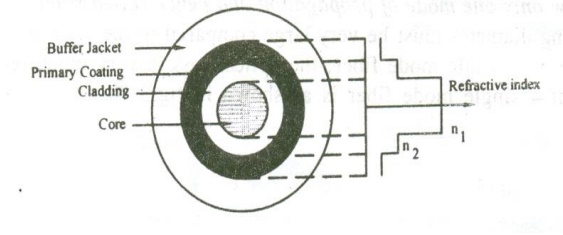
Structure:
Core diameter : 50-350μm
Cladding diameter : 125μm - 500μm
Protective layer : 250 to 1100μm
Numerical aperture : 0.12 to 0.5
Band width : Less than 50MHz km.
The total number of modes possible for such an electromagnetic wave guide is
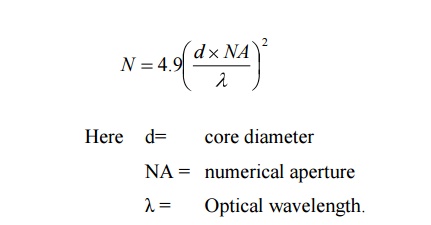
Application:
Because of its less band width it is very useful in short haul communication systems.
DIFFERENCES BETWEEN SINGLE AND MULTIMODE FIBER
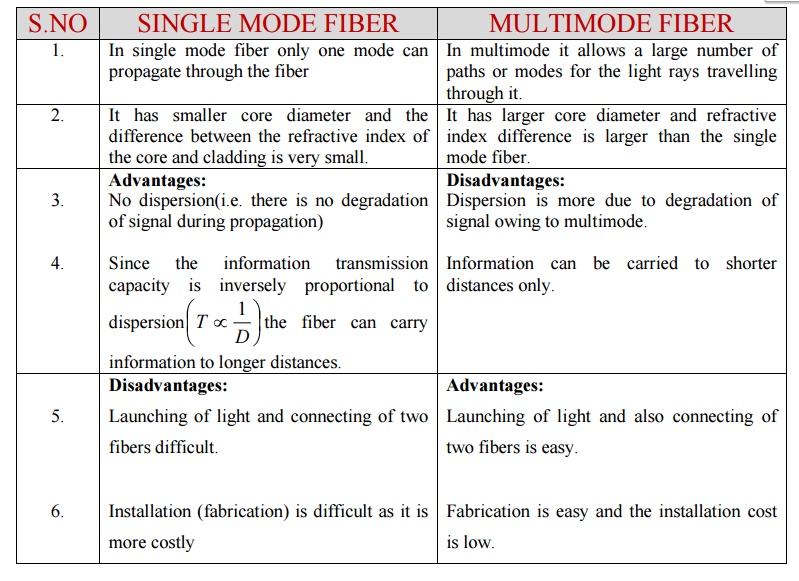
SINGLE MODE STEP INDEX FIBER
A single mode step index fiber consists of a very thin core of uniform refractive index surrounded by a cladding of refractive index lower than that of core. The refractive index abruptly changes at the core cladding boundary. Light travels along a side path, i.e., along the axis only. So zero order modes is supported by Single Mode Fiber.
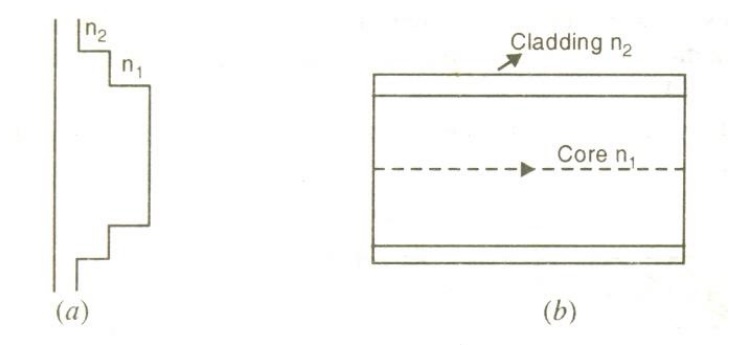
MULTIMODE STEP INDEX FIBER
A multimode step index fiber consists of a core of uniform refractive index surrounded by cladding of refractive index lower than that of the core. The refractive index abruptly changes at the core cladding boundary. The core is of large diameter. Light follows zigzag paths inside the fiber. Many such zigzag paths of propagation are permitted in Multi Mode Fiber. The Numerical Aperture of a Multi mode fiber is larger as the core diameter of the fiber is larger.

GRADED INDEX FIBER
GRIN fiber is one in which refractive index varies radially, decreasing continuously in a parabolic manner from the maximum value of n1, at the center of the core to a constant value of n2 at the core cladding interface.

In graded index fiber, light rays travel at different speeds in different parts of the fiber because the refractive index varies through out the fiber. Near the outer edge, the refractive index is lower. As a result, rays near the outer edge travel faster than the rays at the center of the core. Because of this, rays arrive at the end of the fiber at approximately the same time. In effect light rays arrive at the end of the fiber are continuously refocused as they travel down the fiber. All rays take the same amount of time in traversing the fiber. This leads to small pulse dispersion.

For a parabolic index fiber, the pulse dispersion is reduced by a factor of about 200 in comparison to step index fiber. It is because of this reason that first and second generation optical communication systems used near parabolic index fibers.
PROPAGATION OF LIGHT IN GRIN FIBER
Let na, nb,nc,nd etc be the refractive index of different layers in graded index fiber with na > nb> nc> nd etc. then the propagation of light through the graded index fiber is as shown in the figure.

Here, since na > nb the ray gets refracted. Similarly since nb> nc, the ray gets refracted and so on. In a similar manner, due to decrease in refractive index the ray gets gradually curved towards the upward direction and at one place , where in it satisfies the condition for total internal reflection,(ϕ > ϕc ) it is totally internally reflected .
The reflected rays travels back towards the core axis and without crossing the fiber axis, it is refracted towards downwards direction and again gets totally internally reflected and passes towards upward direction. In this manner the ray propagates inside the fiber in a
helical or spiral manner
Related Topics